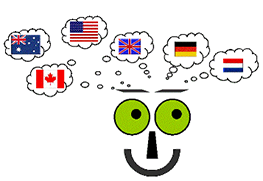This content has been archived. It may no longer be relevant

When people need words or phrases translated, their first instinct is generally to turn to an instant translator, such as Google Translate or other similar tools. It’s easy to see the appeal, as instant translators provide some undeniable advantages over professional translators. They are fast, free, and often use information directly from actual human translations that are already online. There are also disadvantages to using instant translation tools, including that they are prone to errors, tend to be inconsistent from language to language, and cannot guarantee quality and complete accuracy.
So, while there are positive and negative aspects to instant translation services, the most important thing to decide is whether or not the benefits and positives outweigh the negatives. By weighing both options, it will be easy to decide whether or not it’s time to hire a professional translator
Pros of Instant Translation
Most instant translations are based on a statistical learning approach. This means that instant translations available online are derived from the numerous translations already on the internet. Although this can be more than adequate for languages in which a lot of data is available, this approach is terribly deficient in languages with less of an online presence. Instant translation is helpful in many ways and, while it has its limitations, it’s appealing to many people for a variety of reasons.
Speed
In a world where we can access so many things with just the click of a button, most people expect to get information just as easily and quickly. With this in mind, one of the main advantages of using instant translation services is the speed at which they are able to translate words. In the case of Google Translate, this equates to approximately 2,000 words in less than one second. That’s the speed of light compared to what the best professional human interpreter could ever hope to achieve, and it is ideal if you only have a few words that you need translated. But, be warned: While it’s true that time is money, an inaccurate translation is an inaccurate translation, and it can be costly, no matter how fast it is.
Low or No Cost
Another advantage that instant translators provide is a service that costs nothing or next-to-nothing. For many people, this alone is reason enough to use instant translation services, because the expense of a professional translation service can seem overwhelming. However, if you are in business, this is not be an area in which you should cut expenses. While instant translation tools can save you money up front, in business it’s more important to take into account how much, if any, this cost-cutting move is actually saving you. Your bottom line is crucial as a businessperson, and not getting a proper translation will likely cost you more in the long run than you could ever hope to save.
Pros of Instant Translation
If you use an instant translator, there is no guarantee of a perfect translation. Even in the most commonly spoken languages, there are no safeguards in place to account for all of the variables involved in translating from one language to another. Despite the plethora of information on the internet, the data available used for these translations can be as flawed as it is abundant. This can lead to some errors that you can afford, and others you cannot afford, depending on what you’re using the translation for.
Regardless of your intended use, if you want guaranteed accuracy, an instant translation tool cannot provide it. From basic errors to translations based on educated guesses, instant translation simply cannot replace a professional human translator and, despite all of the advantages of these types of services, there are several undeniable weaknesses.
Prone to Errors
Although most translation services are very accurate as a whole, there are several circumstances in which the mistakes common to such a service can simply not be afforded. One reason for this is that it is impossible to directly translate from one language to another by substituting one word or group of words for another word or group of words. Another factor that leads to these translation mistakes has to do with the data that is available on the languages involved in the translation. When data on both languages is plentiful, the resulting translation can be very accurate. However, when data is limited on one or both languages, accuracy suffers, and you are often left with nothing more than a guess. So, while in some cases translation errors are a direct result of the lack of information available, other times they stem from the mere difficulty of the translation process as a whole.
Inconsistent from Language to Language
Instant translation is not only prone to errors from time to time, but the quality of the translation varies based on which languages are involved in the translation. This is particularly true if you are working with one of the more obscure languages, because while the software may be able to find fairly accurate translations from Spanish to English or vice versa to learn from, it will be less likely to find translations of the same quality for less common languages, such as Albanian or Thai.
Another problem posed by instant translation is that, in many languages, there is not an exact translation for a given word or phrase. And, even worse, certain words and phrases can be commonplace in one language and downright awkward or inappropriate in another language. Even some of the biggest companies in the world have embarrassed themselves a time or two with one of these translation blunders. Whether you’re in business or not, you don’t want to be the one who causes their international compadres to go running the other way by expressing yourself in one of these awkward or inappropriate ways.
Lack of Quality Control
In the case of less common dialects, not only are mistakes made, they are difficult to correct because of the limited amount of data that caused the mistakes in the first place. The problem of too little data can be gradually solved as more and more information regarding that language is produced online, but the pace at which this happens is very slow. An increase in information available most directly affects the accuracy in the translation of common phrases and expressions, and is also helpful in deciphering figures of speech, which are important and generally the most difficult to translate.
Can’t Compete againstSkilled Human Translators

When translating to or from a language without a sufficient number of translations available, these instant translation services may give you a translation that is just plain wrong. Even in common languages, only human translators can fully take into account all of the rules and, more importantly, the culture that needs to be communicated with. And, while there is a lot of good information online, there is also a lot of inaccurate information. It can be difficult to tell the difference if you’re not fluent, or at least functional, in the given language. With that being said, there are also many high-quality human translators, as well as many low-quality human translators. No matter which route you decide to take, quality should be paramount.
Best Uses for Instant Translators
There are several cases in which instant translation is effective enough to be used in place of human translation. In some cases, people are just curious about what somebody is saying in another language or are simply studying the language to learn some basic terminology.
Students
When studying a foreign language, instant translation can be very helpful and, for students taking a semester of French, instant translation tools may very well suffice. It’s also important to note, however, that students attending a reputable school have access to other resources, including books, online learning resources, and, of course, their teachers. In the case of a student, instant translation can be very useful in clearing up the meaning of a word or very short phrase. As a student advances into a more in-depth study of a particular language, this will not suffice, but for anyone just beginning to learn a language, it may be plenty.
People Traveling Abroad (Not on Business)
From the hassle of travel arrangements to just being far from home, traveling to a foreign land can be stressful enough. Add a language barrier to that, and your trip can be next-to-impossible to fully enjoy. For this, instant translation tools can do the job, as they are most effective when used to translate short, common words and phrases. If you’re planning on being abroad for an extended period, it may be wise to work with a professional of some kind, whether that means a teacher or an actual translator. However, for anyone just looking to get away for a week or two, instant translation may be sufficient for your needs.

Best Uses for Human Translation
In other cases, particularly in a business setting, the difference between near-100% and 95% accuracy can be the difference between gaining a new customer base and alienating a potential new customer base. That doesn’t mean that human translation should only be used by those who travel for business. A good, professional translator is helpful in a variety of circumstances, including living abroad and developing a website that is internationally friendly.
Business Travel
If your only goal is to go to Cancun and be able to properly communicate with the locals, then an instant translator may adequately fit your needs. That being said, instant translation should never be used for professional purposes. If you plan to do business internationally, you need to effectively communicate with your international customers. In this case, an instant translator is woefully inadequate, because knowing only a few common phrases will severely limit your ability to interact effectively with those you are dealing with. A professional translator or interpreter will not only provide you with a better vocabulary, he or she will also help you avoid any disastrous cultural faux pas.
So, why is an instant translator not enough for the international businessperson? Simply put, because it is impossible for programs that provide instant translation, no matter how accurate, to express the emotion of another language or to do justice to the beauty of the non-native language. To this end, human translators cannot be replaced
Business Website Translation
Simply because your business has a website that is successful in one language, it doesn’t mean that the process of translating your content into another language should be taken lightly. As you already know, there is a huge value in creating business content in multiple languages, and negative implications for not doing so.
To create this content, however, requires the realization that you are doing more than simply translating it from one language to another – you are producing new material for this new audience while still maintaining the message you want to convey. Why not just do a direct translation provided by an instant translation tool? The short answer is that it is impossible because of the complexity of language. Your intended meaning can change or get lost altogether, which, in business, you cannot afford. You need your audience to know not only what you’re saying, but why it’s important to them specifically.
Living Abroad
If you plan on living in a country whose language you don’t speak, you need to learn the native tongue. Sometimes this involves studying and being around the culture to become familiar with the language, but it doesn’t hurt to employ a professional translator to make your transition smoother. Not only will this help you adjust to living outside of your home country, it will also help endear you to the local community. Your willingness to adapt to the language and customs of a culture you want to become a part of will go a long way in determining how well you will adjust to your new surroundings.

The Verdict
On your next trip to Beijing, you’d hate to open up a menu and find “roasted husband” on the list of appetizers, or be told to “eat your fingers.” Even more important than the discomfort these translation gaffes could cause, is that they are confusing and fail to get your intended message to your customer. Your international customers and business partners will be confused or even downright offended if your business makes a similarly poor translation. At best, this type of error will invoke laughter from your intended audience (not good in business) and, at worst, will arouse feelings of resentment and alienate your audience altogether.
So, what is the best choice: instant translators or human translators? The answer is that it depends on how important near-100% accuracy is to you. While instant translators certainly have their place in the world of translation, they can in no way replace professional human translators. When making your decision between the two, the most important thing to remember is to take into account what is at stake. Maybe the difference between getting 95% and 100% on your Spanish exam isn’t that big of a deal to you, but that small difference can mean everything when it comes to building business and personal relationships.
Whatever you do, never underestimate the value of getting the best translation possible from a professional service, because your audience will be the first to know if you don’t.
Bio
TrueLanguage offers businesses of all sizes the ability to enter the global marketplace. We offer a variety of language services, so, no matter what you require, we likely offer a service that meets your needs.




